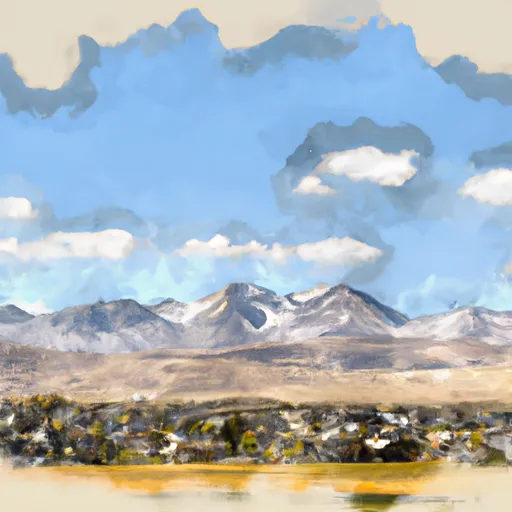-
 Snoflo Premium
Snoflo Premium
Get unlimited access to all our content
With no Ad interruptions! - Start Your Free Trial Login with existing account
Crowley-Lake
Eden Index
Climate
7.9
•
Recreation
9.4
•
Community
•
Safeguard
6.5/10

Crowley Lake is a reservoir located in the Eastern Sierra Nevada mountain range in California. The climate in Crowley Lake is arid, with hot summers and cold winters. The lake is fed by the Owens River and is home to a variety of hydrology constituents, including rainbow and brown trout, as well as schools of kokanee salmon. Outdoor recreation opportunities in the area include fishing, boating, hiking, and camping. The lake is also a popular destination for kayaking and stand-up paddleboarding. Hiking trails in the surrounding area offer stunning views of the Sierra Nevada mountain range and the lake itself. Crowley Lake is a popular destination for outdoor enthusiasts looking to take advantage of the natural beauty of the Eastern Sierra Nevada.
What is the Eden Index?
The Snoflo Eden Index serves as a comprehensive rating system for regions, evaluating their desirability through a holistic assessment of climate health, outdoor recreation opportunities, and natural disaster risk, acknowledging the profound impact of these factors on livability and well-being.
Climate Health Indicator (CHI): 7.9
Crowley-Lake receives approximately
508mm of rain per year,
with humidity levels near 64%
and air temperatures averaging around
7°C.
Crowley-Lake has a plant hardyness factor of
6, meaning
plants and agriculture in this region thrive during a short period during spring and early summer. Most
plants will die off during the colder winter months.
By considering the ideal temperature range, reliable water supplies, clean air, and stable seasonal rain or snowpacks, the Climate Health Indicator (CHI) underscores the significance of a healthy climate as the foundation for quality living.
A healthy climate is paramount for ensuring a high quality of life and livability in a region, fostering both physical well-being and environmental harmony. This can be characterized by ideal temperatures, reliable access to water supplies, clean air, and consistent seasonal rain or snowpacks.
Weather Forecast
Streamflow Conditions
Mono-Owens Lakes
Area Rivers
Mono-Owens Lakes
Snowpack Depths
Mono-Owens Lakes
Reservoir Storage Capacity
Mono-Owens Lakes
Groundwater Levels
Recreational Opportunity Index (ROI): 9.4
The Recreational Opportunity Index (ROI) recognizes the value of outdoor recreational options, such as parks, hiking trails, camping sites, and fishing spots, while acknowledging that climate plays a pivotal role in ensuring the comfort and consistency of these experiences.
Access to outdoor recreational opportunities, encompassing activities such as parks, hiking, camping, and fishing, is crucial for overall well-being, and the climate plays a pivotal role in enabling and enhancing these experiences, ensuring that individuals can engage in nature-based activities comfortably and consistently.
Camping Areas
| Campground | Campsites | Reservations | Toilets | Showers | Elevation |
|---|---|---|---|---|---|
| Mono Hot Springs | 28 | 6,555 ft | |||
| Portal Forebay | 10 | 7,179 ft | |||
| Upper Pine Grove | 8 | 9,395 ft | |||
| Sagehen Meadows | 9 | 8,385 ft | |||
| Vermillion | 32 | 7,663 ft | |||
| Rock Creek Lake | 28 | 9,722 ft | |||
| Lower Pine Grove | 11 | 9,375 ft | |||
| Mosquito Flat | 10 | 10,228 ft | |||
| Jackass Meadow | 48 | 7,170 ft | |||
| Palisade | 6 | 8,873 ft |
Nearby Ski Areas
Catastrophe Safeguard Index (CSI):
The Catastrophe Safeguard Index (CSI) recognizes that natural disaster risk, encompassing floods, fires, hurricanes, and tornadoes, can drastically affect safety and the overall appeal of an area.
The level of natural disaster risk in a region significantly affects safety and the overall livability, with climate change amplifying these risks by potentially increasing the frequency and intensity of events like floods, fires, hurricanes, and tornadoes, thereby posing substantial challenges to community resilience and well-being.
Community Resilience Indicator (CRI):
The Community Resilience Indicator (CRI) recognizes that education, healthcare, and socioeconomics are crucial to the well-being of a region. The CRI acknowledges the profound impact of these elements on residents' overall quality of life. By evaluating educational resources, healthcare accessibility, and economic inclusivity, the index captures the essential aspects that contribute to a thriving community, fostering resident satisfaction, equity, and social cohesion.

